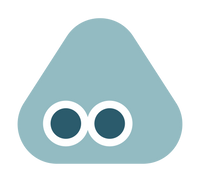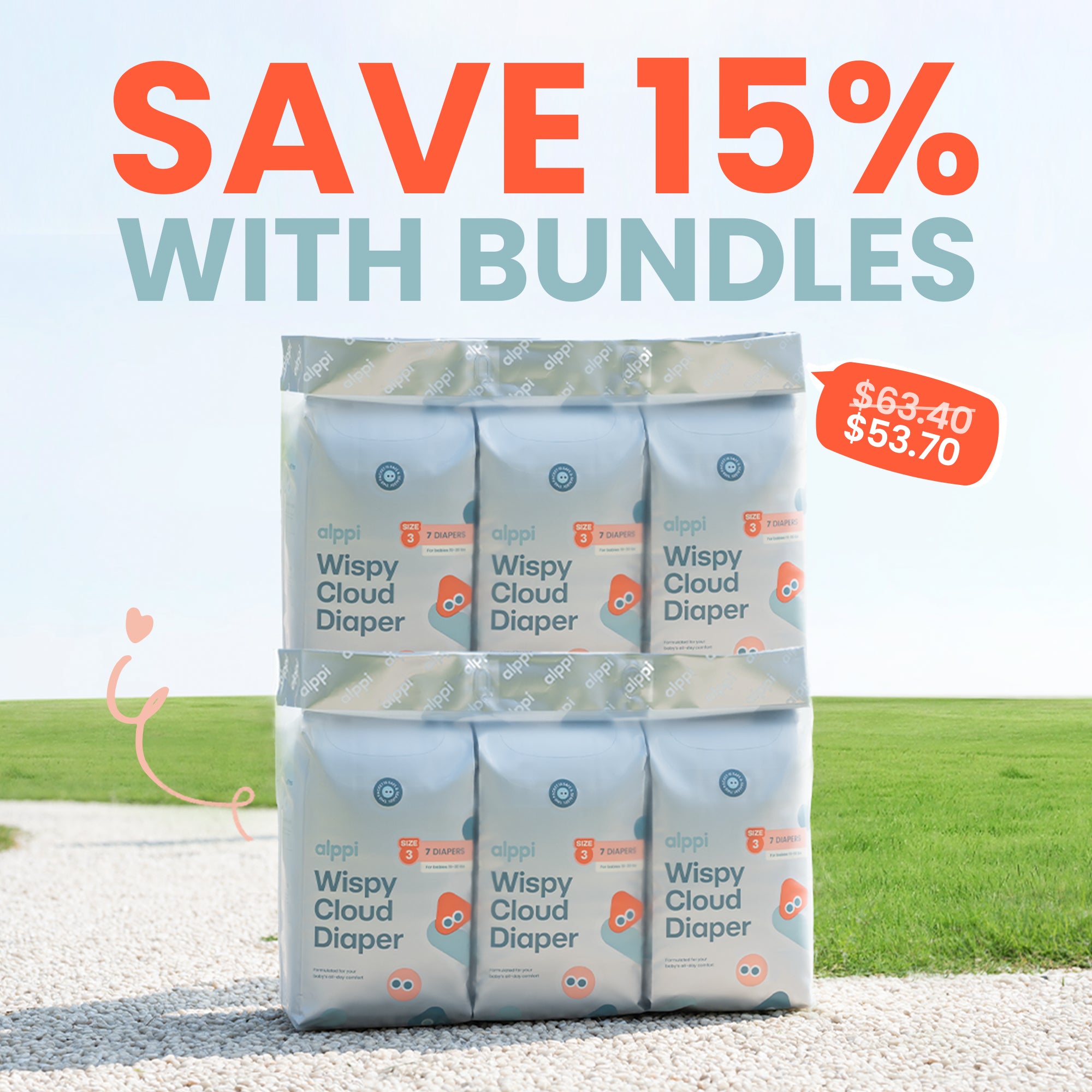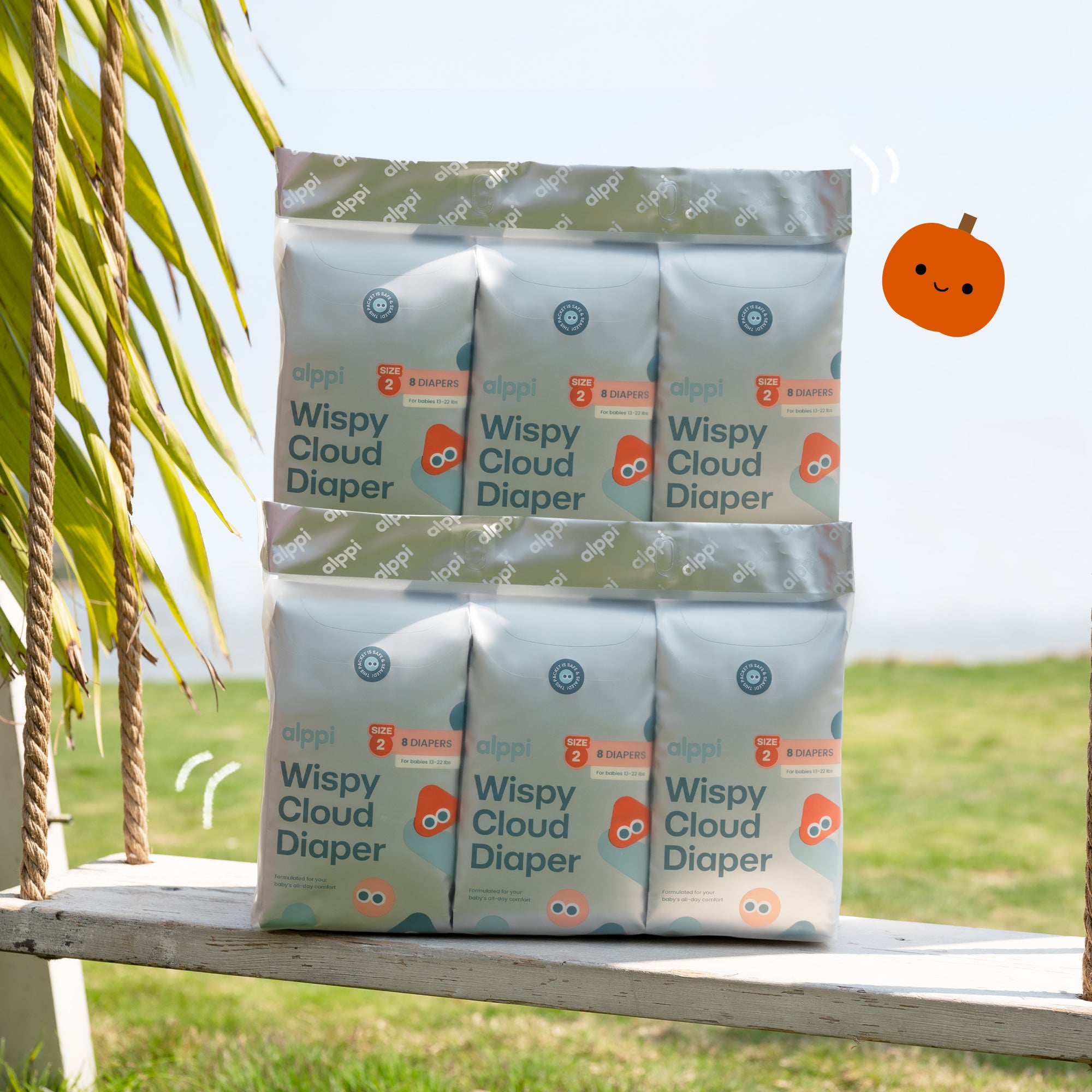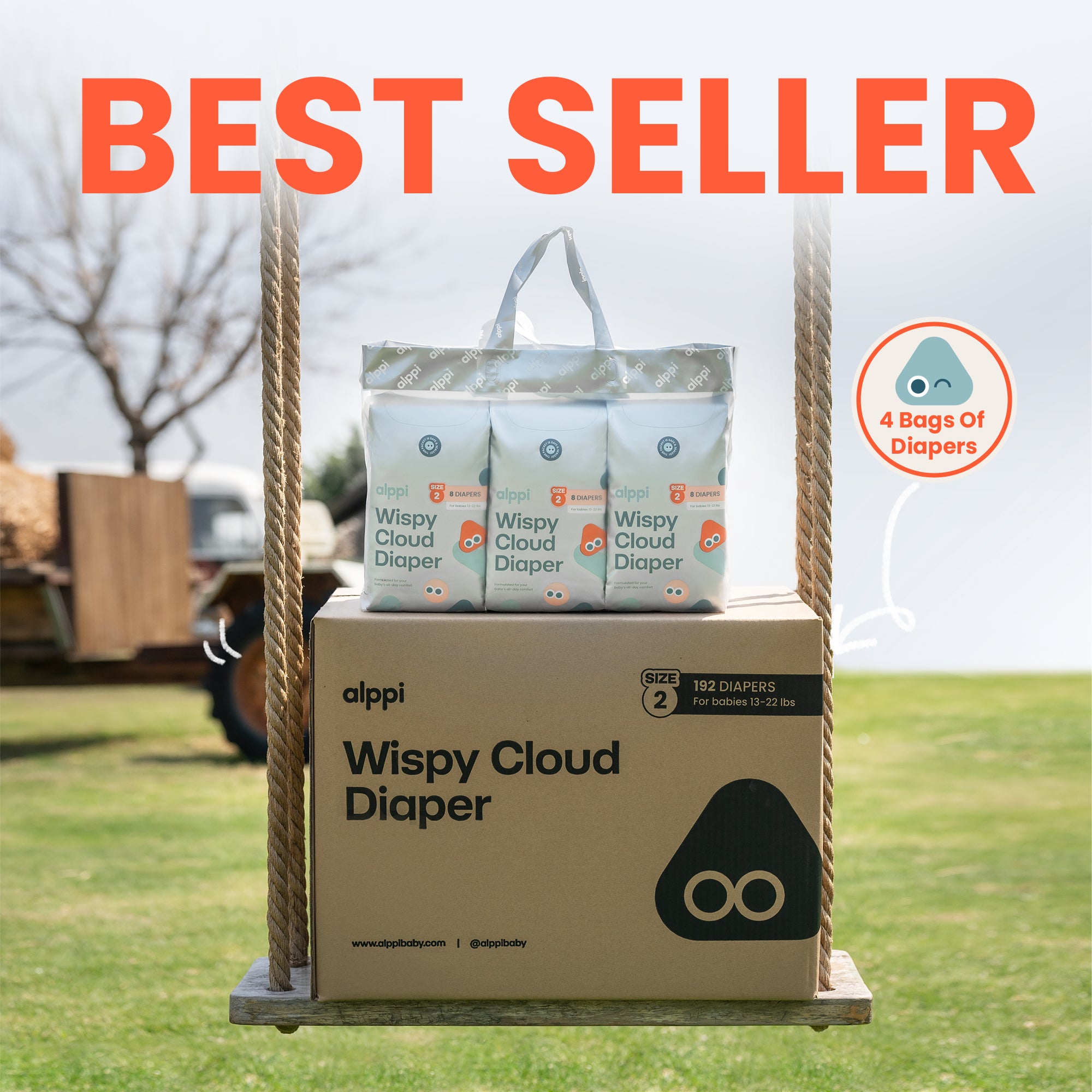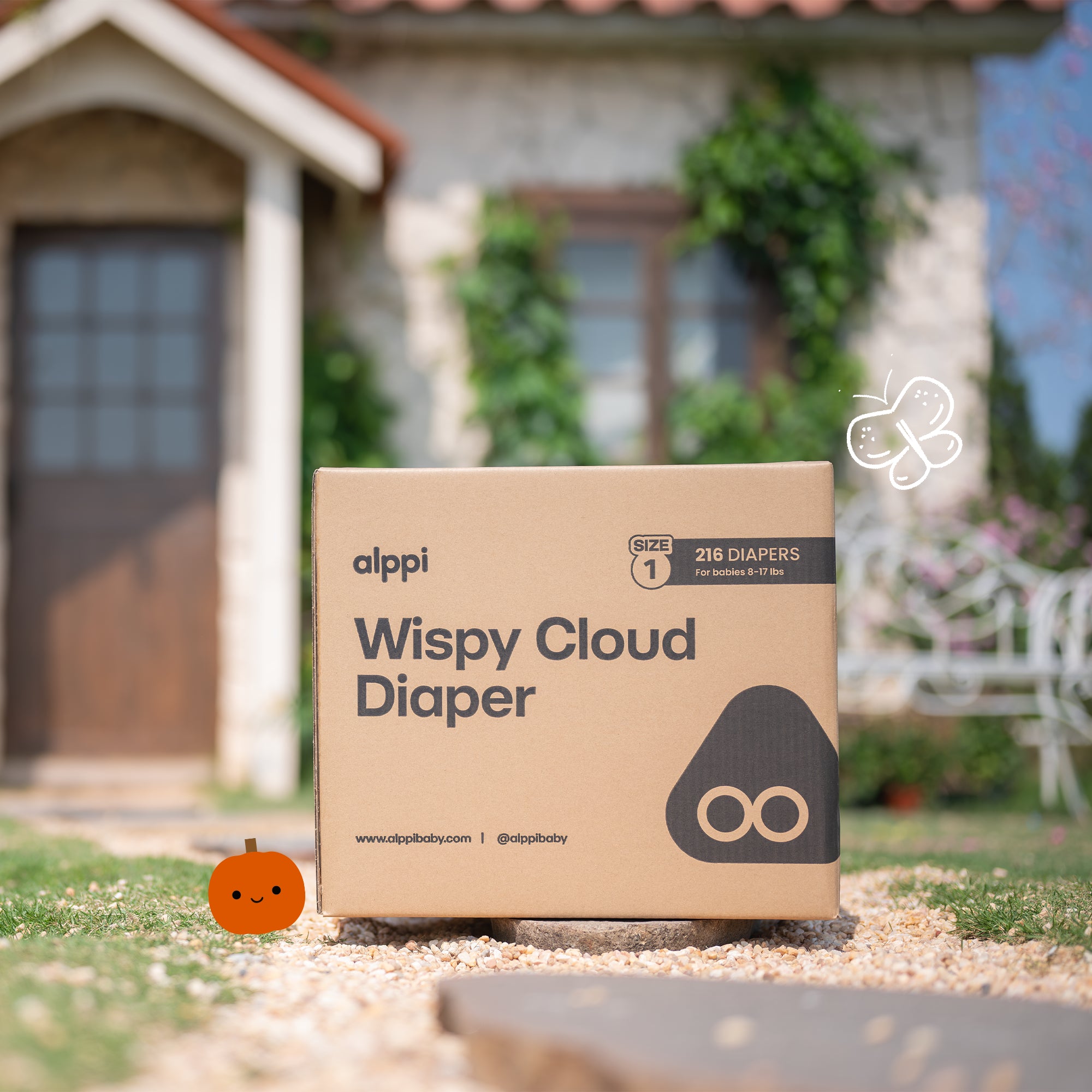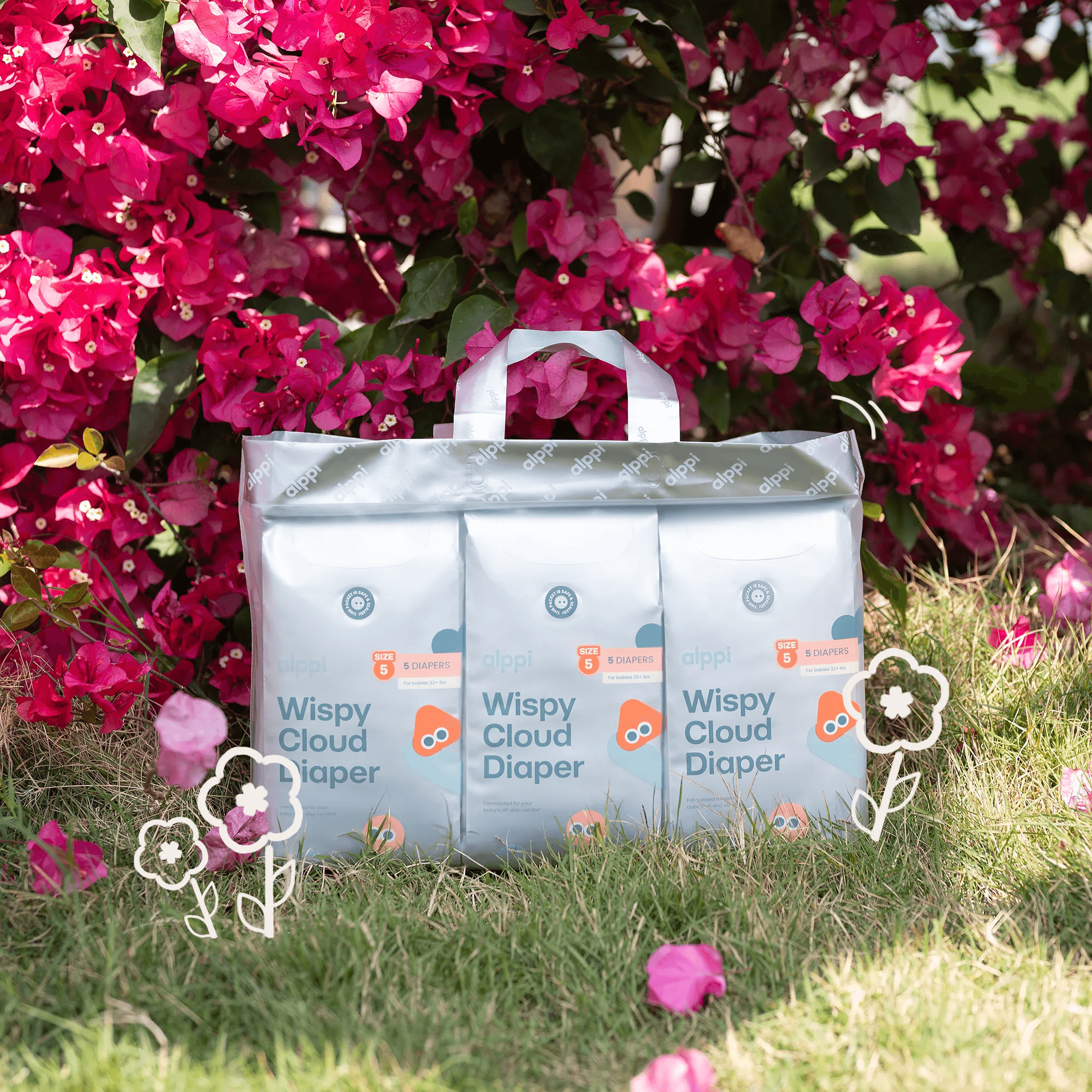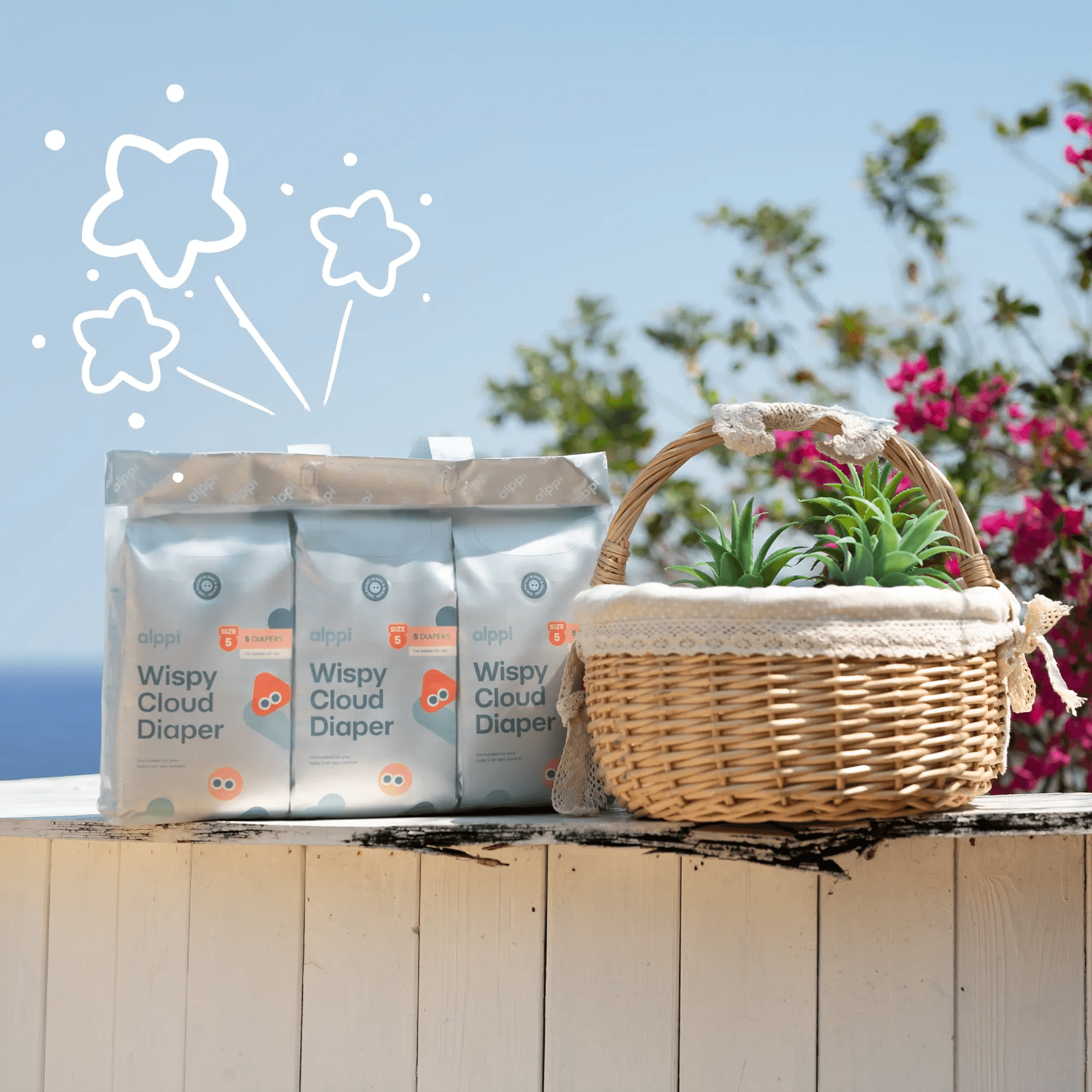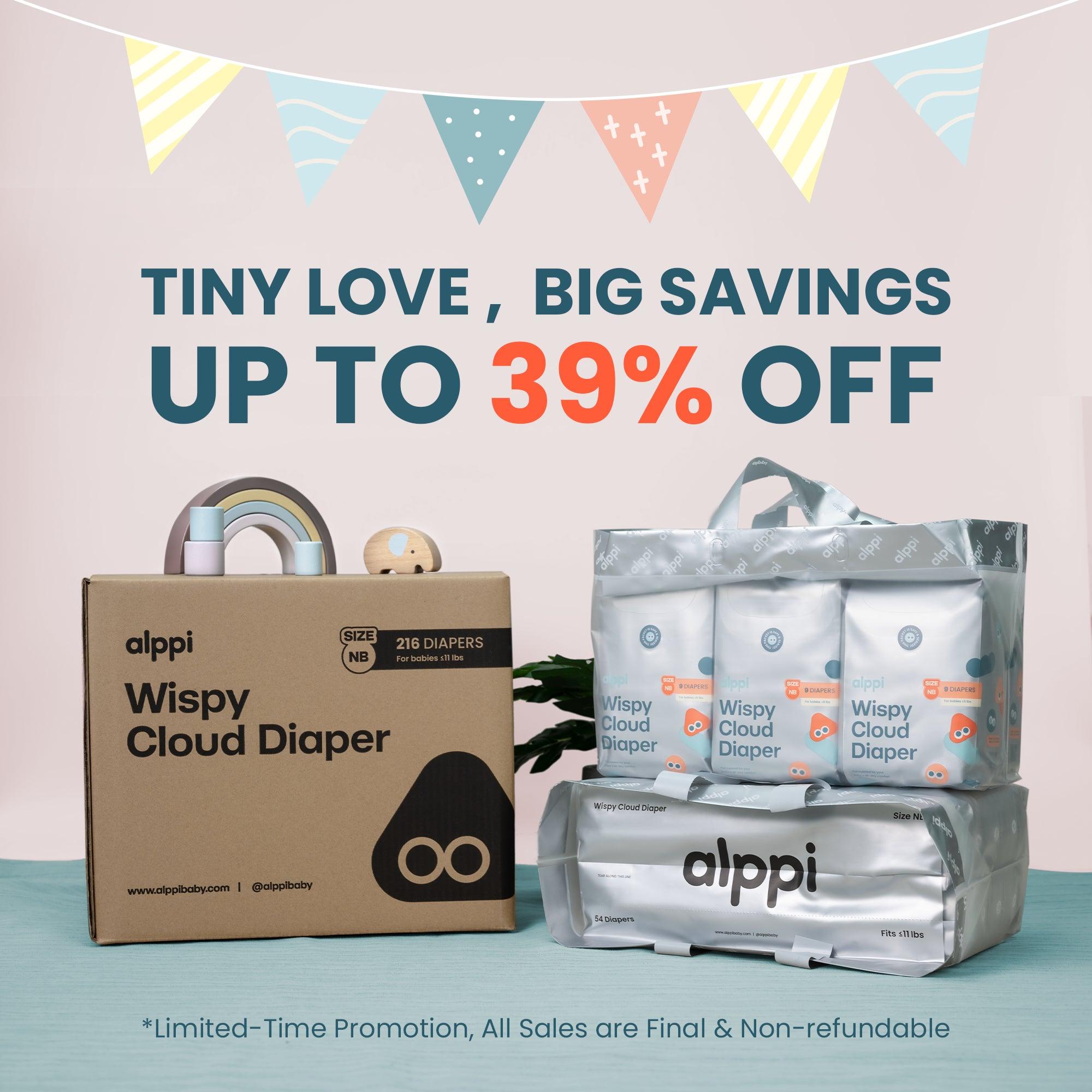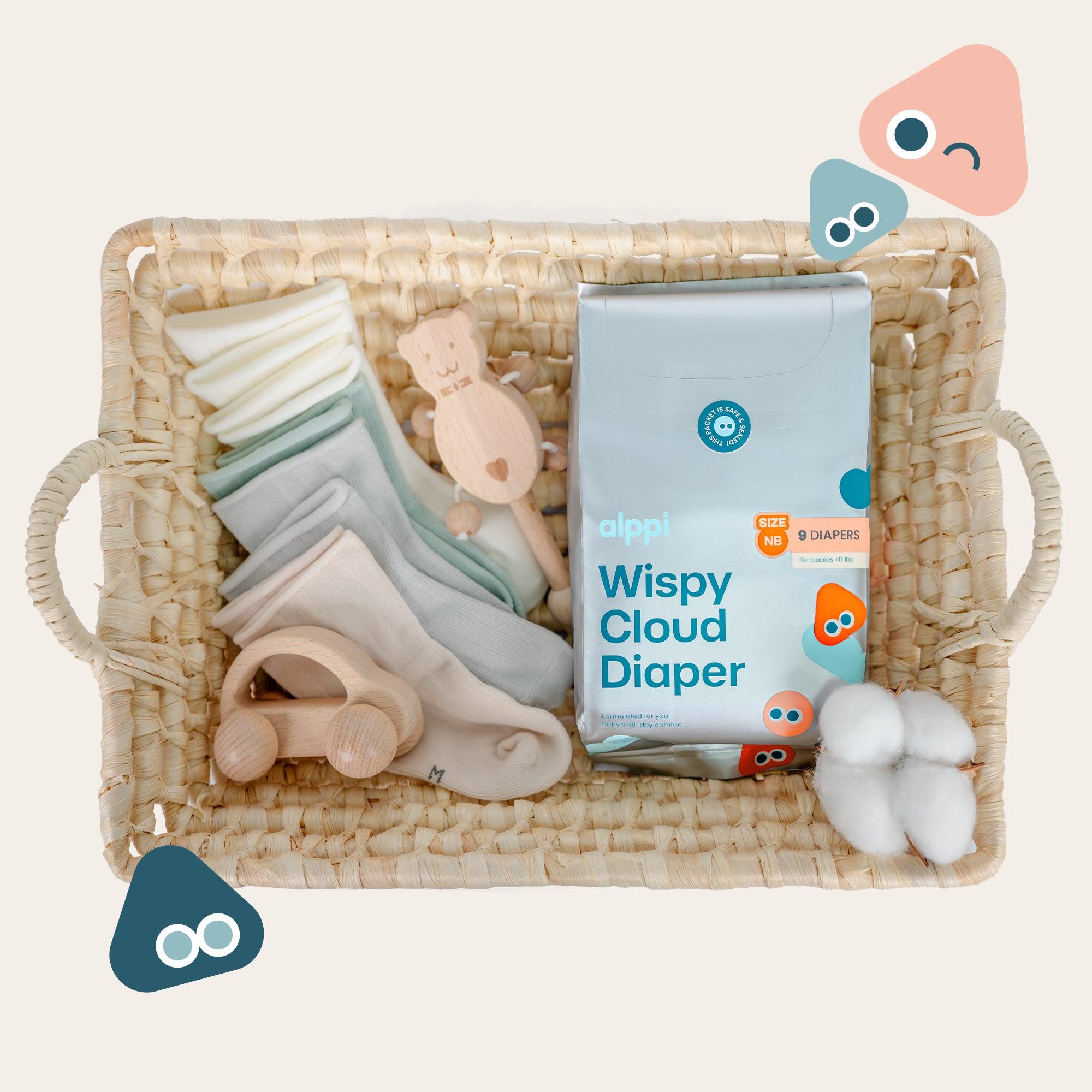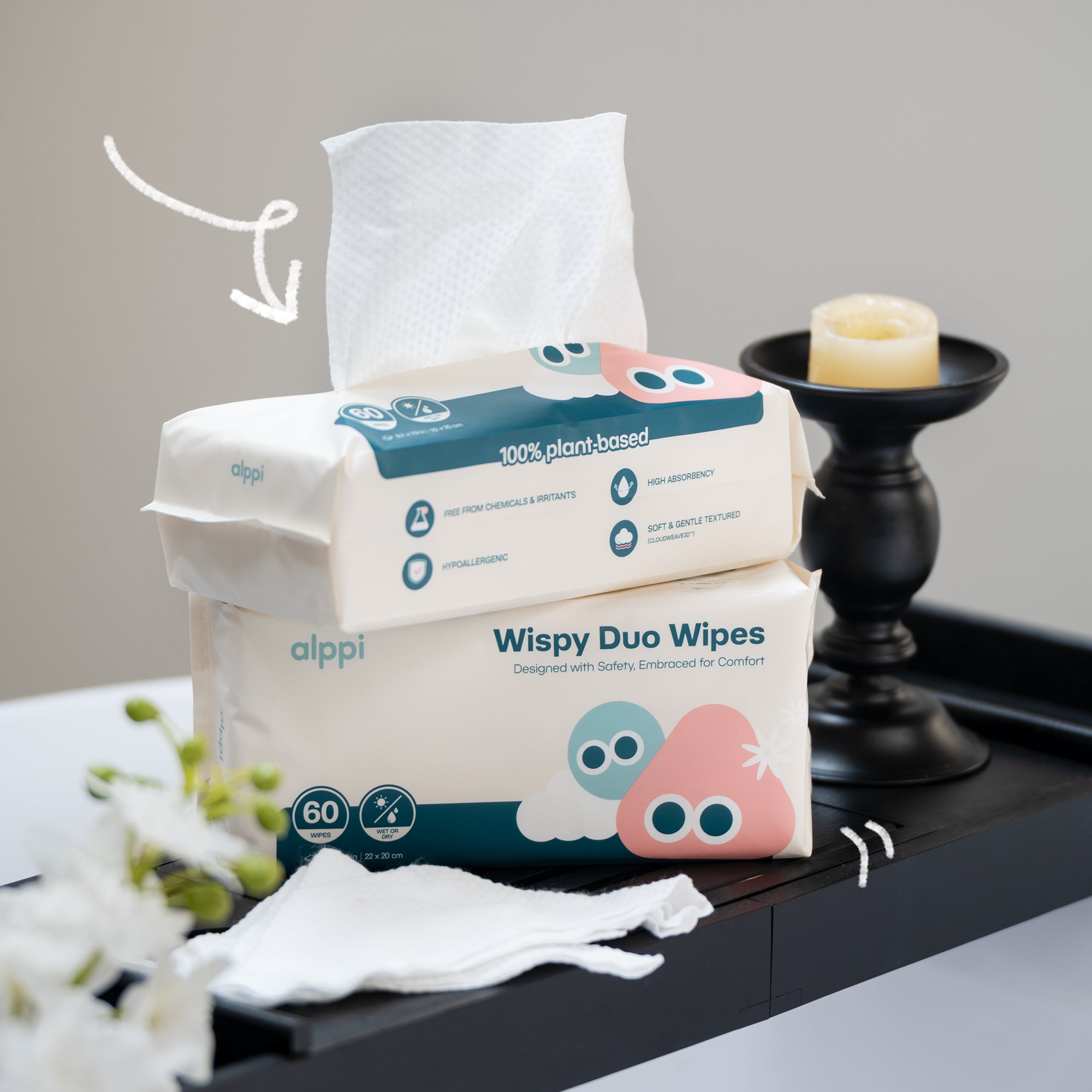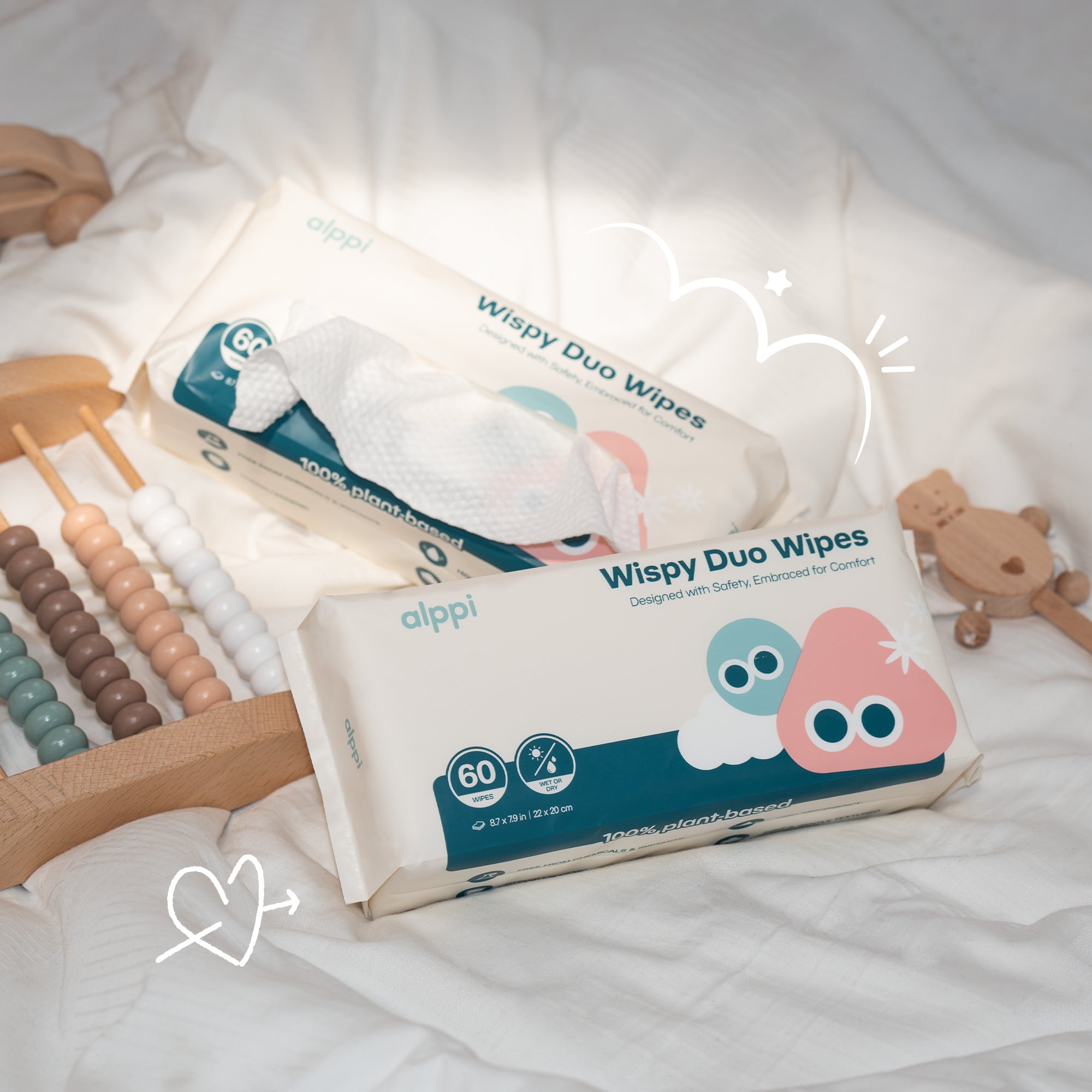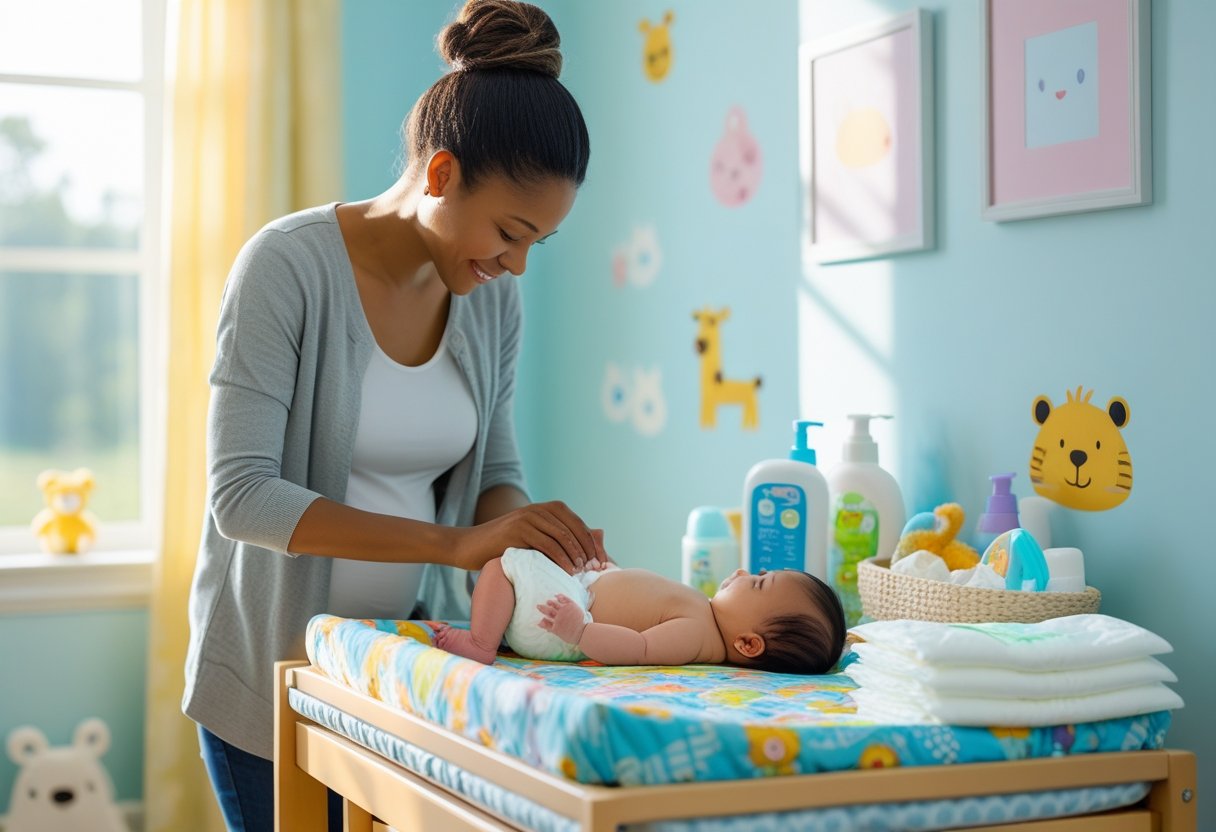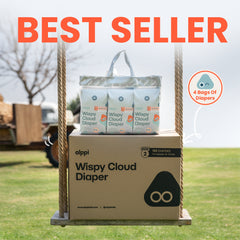Learning how to change a diaper may feel overwhelming at first, but it quickly becomes a simple routine once you know the steps.
To change a diaper, place your baby safely on their back on a flat surface. Remove the soiled diaper and gently clean your baby’s bottom with wipes or a damp cloth. If needed, apply a thin layer of diaper cream to protect against rashes. Slide a clean diaper underneath, fasten it securely but comfortably, and dress your baby.
Once finished, throw away the dirty diaper and wipes in a diaper pail or trash, and wash your hands thoroughly. This simple routine keeps your baby fresh, dry, and comfortable while making diaper duty easier for you.
It’s even easier when you’re using a reliable diaper, such as Alppi Wispy Cloud diaper, which is soft, super absorbent, and gentle on your baby’s skin, making every change smoother and stress-free.
Ready to make diaper changes stress-free and confident? Keep reading for a step-by-step guide you’ll actually find useful.
🍼 Key Takeaways on How to Change a Diaper
- Changing diapers gets easier with practice.
- Always keep your supplies close and ready.
- Clean your baby’s bottom gently at every change.
- Fasten the fresh diaper snugly, but not too tight.
Use a reliable option like Alppi Wispy Cloud Diapers to make changes smoother and keep your baby dry and comfortable.
Diaper Changing Supplies You Need

Keeping the right supplies close by makes diaper changes faster, cleaner, and less stressful.
The type of diaper you use, the setup of your changing space, and how you handle hygiene all play a big role in keeping your baby comfortable and your routine smooth.
Choosing Between Disposable and Cloth Diapers
You’ll likely choose between disposable diapers and cloth diapers, and both have clear pros and cons.
Disposable diapers are convenient, easy to use, and widely available. They’re especially helpful for nighttime or when you’re away from home. The downside is cost over time and the amount of waste they create.
Cloth diapers save money long-term and reduce landfill waste. They come in different styles, from prefolds to all-in-ones, and most are machine washable.
The tradeoff is that they require more laundry and planning, especially if you don’t have easy access to a washer and dryer.
Some parents use a mix of both. For example, you might use cloth diapers during the day at home and switch to disposables for travel or overnight.
Having newborn diapers on hand in both styles can help you figure out which works best for your lifestyle.
Must-Have Items for Your Changing Station
A well-stocked changing station makes the process easier.
At minimum, you’ll need:
- Clean diapers (cloth or disposable)
- Baby wipes or soft washcloths
- Diaper rash cream or ointment
- Changing pad for comfort and protection
- Hand sanitizer for quick cleanups
- Diaper pail or sealed trash can for soiled diapers
A changing table is optional but helpful, especially if it has storage shelves for supplies. If you don’t have one, a portable changing pad on a safe surface works just as well.
Keep extra clothes nearby since leaks and blowouts are common.
Organizing supplies in baskets or small bins saves time and prevents you from leaving your baby unattended. Always restock your station so you’re not scrambling mid-change.
Make it easier with Alppi’s Diaper Weekly Bundle Pack—pre-packed daily diaper packs that keep you stocked and stress-free.
Safe and Hygienic Setup Tips
Safety and hygiene matter just as much as convenience. Always keep one hand on your baby when using a changing table. Babies can roll suddenly, even newborns.
If you’re using a portable pad on the floor, choose a clean, flat surface. Wipe down the changing pad often with a baby-safe cleaner. For cloth pads, wash the cover regularly.
Keep hand sanitizer within reach but out of your baby’s grasp. This helps you clean your hands quickly if you can’t step away to wash with soap and water.
Dispose of soiled diapers right away in a diaper pail or sealed bag to control odors and bacteria.
If you use cloth diapers, store them in a wet bag or lined pail until wash day. Keeping everything tidy not only protects your baby’s skin but also makes your space feel calmer and more organized.
Changing diapers is easier when safety comes first. See why in our article: Why Alppi's Wispy Cloud Diapers Put Your Baby's Safety First.
Step-by-Step Guide: How to Change a Diaper

Changing a diaper takes a mix of preparation, gentle care, and attention to hygiene.
You’ll need the right supplies within reach, a safe place to change your baby, and a clear routine that keeps the process quick and comfortable.
1. Preparation and Safety First
Always set up a safe, clean space before you start. A changing pad on a flat surface or a changing table with safety straps works best.
The American Academy of Pediatrics (AAP) advises never leaving your baby unattended, even for a few seconds.
Gather your supplies so you don’t need to step away.
You’ll need:
- 1 clean diaper
- Baby wipes
- Diaper cream (if needed)
- A plastic bag or diaper pail for the soiled diaper
Wash your hands before and after each diaper change.
If soap and water aren’t nearby, use hand sanitizer. Keeping everything within arm’s reach keeps your baby safe and makes the process smoother.
2. Removing the Soiled Diaper
Lay your baby on the changing pad and gently unfasten the soiled diaper.
Hold your baby’s ankles with one hand and lift their bottom slightly. This gives you room to fold the front of the diaper down without making a mess.
Use the front of the diaper to wipe away the bulk of urine or stool. Fold the dirty part inward to contain the mess. Slide it out from under your baby but keep it nearby until you finish cleaning. Always keep one hand on your baby for safety.
Babies can roll suddenly, so stay alert.
Place the soiled diaper into a diaper pail or sealed bag right away to control odor and germs.
3. Cleaning the Diaper Area
Use baby wipes or a damp, soft cloth to clean the diaper area thoroughly.
For girls, wipe front to back to prevent bacteria from spreading.
For boys, gently clean around the penis and under the scrotum.
Make sure all skin folds are clean and dry. Moisture left behind can cause irritation or diaper rash.
If your baby has sensitive skin, fragrance-free wipes or warm water with a soft cloth may be gentler.
Pat the area dry with a clean cloth. Apply a thin layer of diaper cream if your baby has redness or if your pediatrician recommends it. This creates a barrier that protects the skin during future diaper changes.
4. Putting On a Clean Diaper
Slide a clean diaper under your baby while holding their ankles gently. The back side with the tabs goes under the bottom, and the front pulls up between the legs.
Fasten the tabs snugly but not too tight. You should be able to slip two fingers between the diaper and your baby’s stomach.
Check that the leg cuffs are pulled out; this helps prevent leaks.
For newborn boys, point the penis downward before closing the diaper to reduce leaks.
Once the diaper is secure, dress your baby and wash your hands again. Keep your supplies stocked so the next diaper change is just as smooth.
Every diaper change feels smoother with the right choice. Explore the Alppi Wispy Cloud Diapers collection for softness, safety, and reliable absorbency.
Caring for Your Baby’s Skin During Diaper Changes

Your baby’s skin is delicate, and the diaper area needs extra attention to stay healthy.
Good habits like cleaning gently, keeping the area dry, and using protective creams can help reduce irritation and prevent common issues.
Preventing and Treating Diaper Rash
Diaper rash happens when moisture, friction, or irritants break down the skin. Wet diapers left on too long are the most common cause.
The AAP recommends checking diapers often and changing them as soon as they’re wet or soiled.
Always wipe gently, moving front to back to avoid spreading bacteria.
For stubborn messes, use warm water and a soft cloth instead of wipes with alcohol or fragrance.
If you notice redness, give your baby’s skin time to air out. A few minutes without a diaper after each change can help the area heal faster.
For more serious rashes, especially if they don’t improve in a couple of days, call your pediatrician since it may be a yeast infection.
Using Diaper Cream and Baby Powder
Diaper creams and ointments create a barrier that protects your baby’s skin from moisture. Look for products with zinc oxide or petrolatum, which are safe and effective.
Apply a thin but even layer at each change, especially at night when diapers stay on longer. You don’t need to scrub off every trace of cream during the next change.
Gently wipe away waste, then reapply. This keeps the skin shielded without over-irritating it.
Baby powder, however, is not recommended by the AAP. The fine particles can irritate your baby’s lungs if inhaled.
Instead, focus on creams or ointments for protection. If you prefer a powder-like product, choose cornstarch-based options but always apply carefully away from your baby’s face.
Keeping the Diaper Area Clean and Dry
Moisture is the main trigger for irritation. Change wet diapers promptly, even if they seem only slightly damp.
Disposable diapers usually pull moisture away from the skin, but newborns may still need up to 12 changes a day.
After cleaning, pat the area dry instead of rubbing.
Pay attention to skin folds where moisture can hide. If possible, let your baby go diaper-free for short periods to allow airflow.
Avoid fabric softeners or dryer sheets on cloth diapers since they can leave residue that irritates sensitive skin.
A simple wash routine with hot water and an extra rinse cycle works best to keep diapers clean and gentle.
A smooth diaper change depends on the right diaper. Learn more in our article: What Makes a Good Diaper?
Final Thoughts
Changing diapers doesn’t have to be stressful. With the right setup and a simple step-by-step routine, you can keep your baby clean, comfortable, and rash-free.
Remember the basics: prepare your supplies, clean thoroughly, apply cream if needed, and secure the diaper snugly.
Over time, you’ll find your own rhythm and diaper duty will feel like second nature. The more confident you become, the smoother the process will be for both you and your baby.
Now that you know the essentials of how to change a diaper, you’re ready to handle every change like a pro.
Don’t forget—changing diapers is always easier with the right product. Stay stocked and stress-free with Alppi’s Mothly Diaper Box. See why parents love this system, by reading Why Alppi's Diaper Bag Is Every Parent's Dream Come True!
After mastering diaper changes, it’s worth knowing what’s in them. Read Why Chlorine-Free Diapers Matter?
Frequently Asked Questions
Do you change a pee diaper right away?
You don’t always need to rush after every wet diaper, but you shouldn’t wait too long either.
For newborns, frequent changes are best since their skin is extra sensitive.
At night, many parents use more absorbent diapers so their baby can sleep longer without discomfort.
How to change a diaper without making a mess?
Keep everything you need—wipes, a clean diaper, and cream—within arm’s reach before you start. Slide the clean diaper under your baby before removing the dirty one to catch any sudden leaks.
Using a changing pad cover or disposable liner makes cleanup easier if accidents happen mid-change.
Do you wipe a baby after pee?
If your baby only peed, a full wipe isn’t always necessary, especially with newborns who have delicate skin.
Still, wiping at least once every few changes helps reduce bacteria and odor. Always wipe front to back for girls to prevent infection.
What not to do when changing a diaper?
Don’t leave your baby unattended, even for a second, since they can roll or wiggle off the surface.
Avoid using too many wipes, as this can irritate the skin. Never fasten the diaper too tightly. Snug is enough to prevent leaks without leaving red marks.
How often should I be changing my 2-year-old's diaper?
Most toddlers need a change every 2 to 3 hours during the day.
At this age, many kids also start showing signs of readiness for potty training, so you may notice fewer wet diapers.
Nighttime usually requires one absorbent diaper that can last until morning unless it becomes very full.
